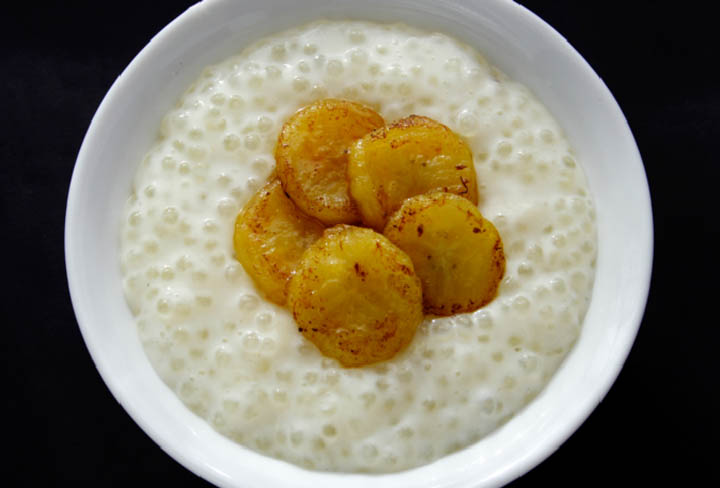Sago (Cycas revolute) is a type of starch extracted from the piths of tropical palms like Metroxylon sagu. The sago palm is native to many countries of the world, including Indonesia, Malaysia, the Philippines, and Papua New Guinea. Sago is a versatile carbohydrate and a primary source for some around the world. Sago Palms grow in full sun, but can adapt to outdoor shade or an indoor area with some lighting.
Sago is almost pure carbs and low in most nutrients. It’s naturally gluten-free and suitable for those on grain-free diets. Sago contains antioxidants and resistant starch and has been linked to many benefits, including improving risk factors for heart disease and enhancing exercise performance. It can be purchased in two main forms — flour or pearls. While the flour is pure starch, the pearls are small balls of sago that are made by mixing the starch with water and partially heating them.
In Guyana however, Sago pearls is used to make Sago Porridge – A powerful and delicious energy boost.

Sago Porridge – Photo by Cynthia Nelson (https://www.stabroeknews.com/2014/03/09/features/cardamom-elaichi-sago-pudding/)
Origin Of Sago
Metroxylon sagu, the true sago palm grows in tropical lowland forests and freshwater swamps, in Southeast Asia and New Guinea. These palms can grow in most soil types and reaches heights of thirty (30) meters tall. Apart from Metroxylon sagu there are several other species of the genus Metroxylon, from which sago can be extracted like Metroxylon salomonense and Metroxylon amicarum.
Description Of Sago
The sago plants grow fast, in clusters like bananas, matures, flowers, then dies. A new sucker soon replaces the old stem with about 1.5 m growth in height per year. The stems of sago palms support themselves while some may start climbing. Leaves are pinnate and one infloresence is produced by each trunk. At around seven to fifteen (7–15) years, sago palms are harvested, right before or soon after the infloresence appears. A sago palm can produce as much as one hundred to three hundred (150–300) kg of starch.
The new leaves of the sago plant appears together, in a circular pattern. The tend to be soft at first then hardens a few weeks later. Plants getting bright light produces short leaves while low light produces long leaves.
9 Amazing Health Benefits Of Sago
- Helps in Weight Gain – Since sago is packed with carbohydrates, it is a great option if you are living in an area with an inconsistent food supply. If you are malnourished or recovering from an illness or injury, eating sago is a great way to get your weight back on track. When made into pudding, cakes, or porridge, sago can provide extra energy and nutrient needed to reach your weight goal.
- Lowers Blood Pressure – Potassium found in sago, helps to relax the blood vessels which allow for the better flow of blood, thus reducing blood pressure.
- Improves Digestion – Sago is relatively easy to digest. It contains a small amount of fibre which hastens the digestive process and aids in the balancing of bacteria in the intestines.
- Increases Energy – Sago maintains a high level of energy throughout the day.
- Boosts Bone Mineral Density – Although the mineral content in sago is limited, there are
- Small amounts of copper, iron, and calcium helps in the creation of bone tissues. This strengthens bone mineral density, may prevent bone diseases like osteoporosis, and inflammation in the body.
- Hastens Muscle Growth – Eating sago regularly helps the muscles work for a longer period and helps to hasten their growth and repair.
- Reduces Neural Tube Defects – Folic acid, needed for pregnancy is found moderately in Sago. This helps to prevent neural tube defects in infants.
- Improves Nerve Function – Sago positively affects your electrolyte balance in the body, thus helping to improve the working of the nervous system.
- Increases Circulation – Iron, found in sago aids in the production of red blood cells. This, in turn, can improve the blood flow and promote healing and repairs.
Culinary Uses Of Sago Worldwide
- When made into a gruel, sago can be a healthy alternative to carbonated beverages.
- In bubble tea, a popular Asian drink the pearls are made of sago.
- Sago is used in some desserts, pieces of bread, biscuits and crackers.
- Lempeng, a famous Malaysian pancake is made with sago.
- Sago is also used as a thickener.
Here is How to make Sago Porridge – Guyanese style
Ingredients:
- 1/2 cup sago pearls
- cinnamon sticks
- ground nutmeg
- 1/2 cup sugar
- 2 cups milk
- water
Instructions:
- Wash sago.
- Add sago, and water to a pot over flame.
- Allow to boil.
- Mix milk and sugar together and add to the sago on the stove.
- Stir periodically.
- Add cinnamon and nutmeg.
- Remove from heat.
- Serve warm alone or with a few slices of bananas.
Watch This: Recipe II Real Nice Guyana Video
Sago
Sago is native to countries like Malaysia, and New Guinea where they are regularly consumed. It is purely carbs and is low in some nutrients. It can either be purchased in the form of flour or pearls. In Guyana, the sago pearls are used to make sago porridge. Sago has many health benefits, some of which includes – weight gain, improves digestion, increases energy, just to name a few.
Article References:
- https://www.healthline.com/nutrition/sago#uses
- https://www.organicfacts.net/sago.html
- https://www.britannica.com/topic/sago
- https://en.wikipedia.org/wiki/Sago
- http://www.sunpalmtrees.com/Cold-Hardy-Palm-Trees-Sago-Palms.htm
- https://www.livestrong.com/article/470302-what-are-the-health-benefits-of-sago/
- https://www.stabroeknews.com/2014/03/09/features/cardamom-elaichi-sago-pudding/
Last Updated: 2020-07-08






